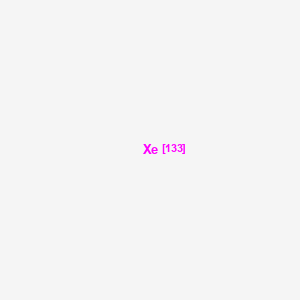Attribution Statement: LactMed is a registered trademark of the U.S. Department of Health and Human Services.
NCBI Bookshelf. A service of the National Library of Medicine, National Institutes of Health.
Drugs and Lactation Database (LactMed®) [Internet]. Bethesda (MD): National Institute of Child Health and Human Development; 2006-.
CASRN: 14932-42-4

Drug Levels and Effects
Summary of Use during Lactation
Information in this record refers to the use of xenon Xe 133 as a diagnostic agent. Because of its low systemic bioavailability after inhalation, the International Commission on Radiological Protection and other experts state breastfeeding need not be interrupted after administration of xenon Xe 133.[1-3]
Drug Levels
Xenon 133 is a beta emitter with a physical half-life of 5.2 days, a photopeak of 81 keV, and beta-decay.[2] Because of the poor solubility of xenon Xe 133, the amount that enters the venous circulation after inhalation is negligible. The small amount of xenon Xe 133 gas that passes into the venous circulation returns rapidly to the lungs to be exhaled.
Maternal Levels. Excretion of nonradioactive xenon in breastmilk was studied in 2 women who underwent about 1 hour of xenon anesthesia with a 65 to 69% inhaled xenon concentration. One mother consumed 8.3 L of xenon and the other had consumed 10 L during the procedure. Milk samples taken at 90 and 300 minutes after extubation contained no detectable xenon.[4]
Infant Levels. Relevant published information was not found as of the revision date.
Effects in Breastfed Infants
Relevant published information was not found as of the revision date.
Effects on Lactation and Breastmilk
Relevant published information was not found as of the revision date.
References
- 1.
- Stabin MG, Breitz HB. Breast milk excretion of radiopharmaceuticals: Mechanisms, findings, and radiation dosimetry. J Nucl Med. 2000;41:863–73. [PubMed: 10809203]
- 2.
- Parker JA, Coleman RE, Grady E, et al. SNM practice guideline for lung scintigraphy 4.0. J Nucl Med Technol. 2012;40:57–65. [PubMed: 22282651]
- 3.
- Mattsson S, Johansson L, Leide Svegborn S, et al. Radiation dose to patients from radiopharmaceuticals: A compendium of current information related to frequently used substances. ICRP Publication 128. Annex D. Recommendations on breast-feeding interruptions. Ann ICRP. 2015;44(2) Suppl:319–21. [PubMed: 26069086]
- 4.
- Stuttmann R, Schafer C, Hilbert P, et al. The breast feeding mother and xenon anaesthesia: four case reports. Breast feeding and xenon anaesthesia. BMC Anesthesiol. 2010;10:1. [PMC free article: PMC2837001] [PubMed: 20167123]
Substance Identification
Substance Name
Xenon Xe 133
CAS Registry Number
14932-42-4
Disclaimer: Information presented in this database is not meant as a substitute for professional judgment. You should consult your healthcare provider for breastfeeding advice related to your particular situation. The U.S. government does not warrant or assume any liability or responsibility for the accuracy or completeness of the information on this Site.
- User and Medical Advice Disclaimer
- Drugs and Lactation Database (LactMed) - Record Format
- LactMed - Database Creation and Peer Review Process
- Fact Sheet. Drugs and Lactation Database (LactMed)
- Drugs and Lactation Database (LactMed) - Glossary
- LactMed Selected References
- Drugs and Lactation Database (LactMed) - About Dietary Supplements
- Breastfeeding Links
- PMCPubMed Central citations
- PubChem SubstanceRelated PubChem Substances
- PubMedLinks to PubMed
- Review Krypton Kr 81m.[Drugs and Lactation Database (...]Review Krypton Kr 81m.. Drugs and Lactation Database (LactMed®). 2006
- Review Technetium Tc 99m Bicisate.[Drugs and Lactation Database (...]Review Technetium Tc 99m Bicisate.. Drugs and Lactation Database (LactMed®). 2006
- Gas chromatography/mass spectrometry measurement of xenon in gas-loaded liposomes for neuroprotective applications.[Rapid Commun Mass Spectrom. 2017]Gas chromatography/mass spectrometry measurement of xenon in gas-loaded liposomes for neuroprotective applications.Klegerman ME, Moody MR, Hurling JR, Peng T, Huang SL, McPherson DD. Rapid Commun Mass Spectrom. 2017 Jan 15; 31(1):1-8.
- A simple device for efficient transfer and unit dose packaging of Xe-127: concise communication.[J Nucl Med. 1978]A simple device for efficient transfer and unit dose packaging of Xe-127: concise communication.Kowalsky RJ, Dalton DR, Saylor WL. J Nucl Med. 1978 Apr; 19(4):414-8.
- 133Xe and stable Xe inhalation measurements of cerebral blood flow in health and disease.[Prog Nucl Med. 1981]133Xe and stable Xe inhalation measurements of cerebral blood flow in health and disease.Meyer JS. Prog Nucl Med. 1981; 7:95-109.
- Xenon Xe 133 - Drugs and Lactation Database (LactMed®)Xenon Xe 133 - Drugs and Lactation Database (LactMed®)
Your browsing activity is empty.
Activity recording is turned off.
See more...
